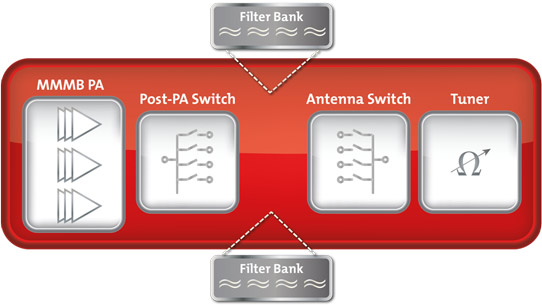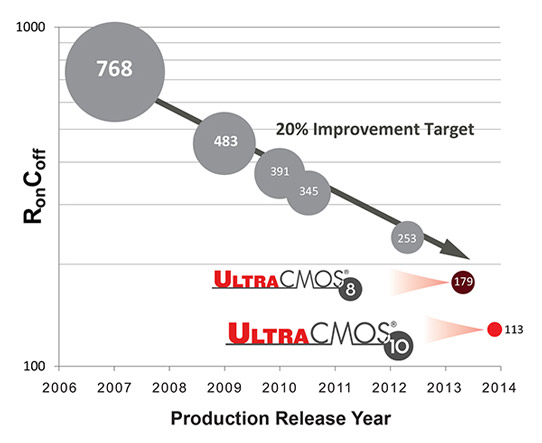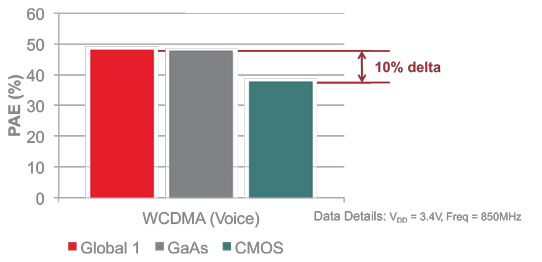- News
4 February 2014
Peregrine challenging GaAs PA market with UltraCMOS Global 1
Peregrine Semiconductor Corp of San Diego, CA, USA, a fabless provider of radio-frequency integrated circuits (RFICs), has claimed the world’s first reconfigurable RF front end (RFFE) using silicon-on-insulator (SOI) complementary metal-oxide-semiconductor (CMOS) technology. The company sees the ‘UltraCMOS Global 1’ device as allowing “for the first time” 4G LTE mobile phone platform providers and OEMs to save time and money through a single design adaptable for global markets that need facilities to tackle 40 frequency bands and a 5000-fold increase in potential operating states.

Figure 1. Block diagram of Peregrine’s reconfigurable RF front end.
The use of a CMOS process enables Peregrine to integrate a 3-path multimode, multiband (MMMB) power amplifier (PA), post-PA switch, antenna switch, and antenna tuner into the Global 1 IC (Figure 1). The device also supports envelope tracking – a technique to tune power consumption to usage. The interface with the mobile phone system is through the common RFFE MIPI interface.

Figure 2. UltraCMOS RonxCoff delay (femtosecond) improvement over time.
Peregrine’s ultra-thin silicon (UTSi) UltraCMOS process on insulating substrates – sapphire or enhanced silicon-on-insulator – has been developed over a period of 25 years. The latest version – UltraCMOS 10 – was announced in 2013 and features Peregrine’s design expertise, SOITEC substrates, and GLOBALFOUNDRIES’ fabrication flow. The measured 37% reduction in the on-resistance, off-capacitance product of 133 femtoseconds (RonxCoff, Figure 2) is expected to feed through to related improvements in linearity, reduced insertion loss and better isolation on a 130nm chip. Competitor SOI CMOS processes tend to have RonxCoff in the range 200-250 femtoseconds.
The company has already deployed UltraCMOS to grab a large share of the RF switch market that was previously mainly the preserve of gallium arsenide (GaAs) device makers. Now the Global 1 CMOS power amplifier challenges the performance of GaAs-based modules, even without envelope tracking, or digital pre-distortion or other enhancement.
The device was tested using a WCDMA (voice) waveform at an ACLR (adjacent channel leakage ratio) of -38dBc and was found to have a power-added efficiency (PAE) of almost 50% (Figure 3). The company comments: “This is on par with the leading GaAs PAs and exceeds the performance of other CMOS PAs by 10 percentage points, which represents a 33% efficiency increase.”

Figure 3. Power added efficiency compared with alternatives.
Peregrine also points out that the benefits of envelope tracking can be very band specific, but typically the system efficiency of Global 1 increases a further 10 percentage points with tracking.
The firm is presently demonstrating the product, for example at the Mobile World Congress (MWC 2014) in Barcelona, Spain (24-27 February). Platform integration is due to be completed this year, with volume production coming online in late 2015.
Peregrine introduces UltraCMOS 10 technology to advance RF design with SOI
The author Mike Cooke is a freelance technology journalist who has worked in the semiconductor and advanced technology sectors since 1997.


